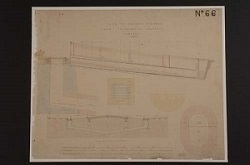Portrait of John Howard Surveying the Harbour, 1835

Howard commissioned an artist named D’Almaine to paint his portrait while surveying the harbour but he chose to paint the background himself.4 He painted a four-columned portico onto Parliament buildings, that was designed, but never built. Thomas Young, a professional rival of Howard’s, created a lithograph of the same buildings which also included the non-existent portico5.
4 Ibid Pg. 14
5 Eric Arthur. From Front Street to Queen’s Park: The Story of Ontario’s Parliament Buildings.McClelland and Stewart: Toronto, 1979. Pg. 38;

A surveyor determines the three-dimensional position of given points, and the angles and distances between them. Defining this data allows the surveyor to create accurate maps of an area, for example, or to determine the location of property lines which is essential to the sale of land3.
3 http://en.wikipedia.org/wiki/Surveyingaccessed December 6, 2013.

